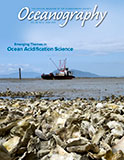Article Abstract
Oceanic and coastal waters are acidifying due to processes dominated in the open ocean by increasing atmospheric CO2 and dominated in estuaries and some coastal waters by nutrient-fueled respiration. The patterns and severity of acidification, as well as its effects, are modified by the host of stressors related to human activities that also influence these habitats. Temperature, deoxygenation, and changes in food webs are particularly important co-stressors because they are pervasive, and both their causes and effects are often mechanistically linked to acidification. Development of a theoretical underpinning to multiple stressor research that considers physiological, ecological, and evolutionary perspectives is needed because testing all combinations of stressors and stressor intensities experimentally is impossible. Nevertheless, use of a wide variety of research approaches is a logical and promising strategy for improving understanding of acidification and its effects. Future research that focuses on spatial and temporal patterns of stressor interactions and on identifying mechanisms by which multiple stressors affect individuals, populations, and ecosystems is critical. It is also necessary to incorporate consideration of multiple stressors into management, mitigation, and adaptation to acidification and to increase public and policy recognition of the importance of addressing acidification in the context of the suite of other stressors with which it potentially interacts.

